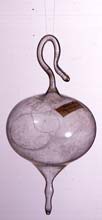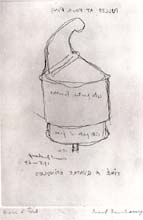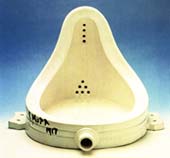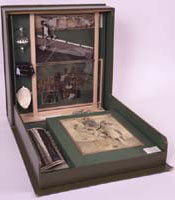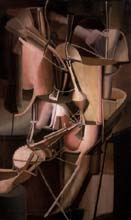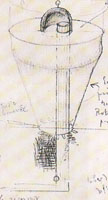| 4b. Bottle in Art in Bottle
Jean Clair (2000) argues that Duchamp surely knew the Klein Bottle and its important topological properties; he also indicates in the previously analized note a possible reference to it. In addition, he hypothesizes that the ampoule of Paris Air (1919) (Fig. 38) could refer to it (both iconographically and because of the problems it poses). This statement holds its validity for others of Duchamp's works as well. The readymade, Pulled at Four Pins (1915) (Fig. 39), a simple chimney cowl, is another example. In the related drawing, which Duchamp made in 1964, at the top of the shape we see a curvature that recalls the glass curl of the ampoule, cited above; furthermore, we must think that a chimney cowl serves to aid the convective circulation of the air between inside and outside.
Let's now consider the famous Fountain (1917) (Fig. 40). It seems to me that it can be seen as a transversal section of a kleinian bottle. The neck for the connection with the water pipe (in the foreground of the historic photo) would be the equivalent of the kleinian bottle neck--plunging in its own belly (here the sectioned part) would reconnect with the holes of the draining (corresponding to the introverted bottom of the kleinian bottle). In fact the double function as a fountain (supplying device, oriented to the outside) and as a urinal (receiving device, oriented to the inside) seems to be the first confirmation of this reading. Often the signature R. Mutt (or Mutt. R., or Mutt Er) is said to stand for Mother (Mutter in German). This adds a further meaning to the association between the Fountain and the kleinian bottle. Indeed, "Mother" is the one which potentially has in her belly her offspring; her belly, i.e. her inside, is everted to the outside by means of her offspring, who in turn contain offspring in inside, who soon will be everted, and so on. In the present of a woman is contained her future; in this contemporaneity of present (inner) and future (outer) that expresses itself in a sort of temporary evertion, we can grasp an analogy with the properties of the kleinian bottle. If we accept this viewpoint,
then we can also understand this very cryptic note in the Box
of 1914:
These considerations cast in turn a new sense on the readymade Family Portrait. We have already recalled that Jean Clair looks at its outline as a template of the Fountain. This comparison is consistent with the observations above. In fact the Mother (with the last born) is at the top vertex of the composition. The exclusion of the male offspring underlines the continuity of the female line in the descent. The male is only a reproductive device: the father is indeed in a peripheral position. Why then is the presence of the young Marcel in a central position? The theory of Marcel's drive for his sister could be a possible explanation, but I think that Marcel's role is simply that of an observer. Finally, I want
to recall that the outline of the Fountain is sometimes regarded
as a symbol of the Buddha. If this is so, and if we want to keep the
kleinian analogy, one wouldn't think of the image of the erect sitting
Buddha, but instead of the one in which the Buddha is completely bent
in on himself, plunged in that inward meditation that opens the door
to the contemplation of the universe. In the above mentioned essay,
Rosen
suggests that:
Duchamp often claims that three particular ready-mades synthesize the world of the Large Glass, and in the Box in a Valise (Fig. 41) they stand vertically placed beside the miniature of the opus maior. They are (from the top): 1. Paris Air, at the height of the Bride; 2. Traveler's Folding Item (1916, an Underwood typewriter cover) at the height of the horizon, where the Bride's cloth is placed; 3. Fountain, placed at the bottom at the level of the Bachelor’s apparatus. I don't want to argue a new exegesis of these associations between the three readymades and the corresponding parts of the Large Glass: in my opinion Shearer's exegesis (located in the second part of her paper) is perfectly convincing. I want instead to underline that at the top and at the bottom of this pile of ready-mades we have two objects referable to the topology of a kleinian bottle (with some straining the intermediate readymade could also be referred to the same topological themes of the others: indeed the cover hints at a well-delimited internal space which however, due to the lack of the bottom, hasn't a well-defined distinction from the outside, just as in the strange prism of Tu m'. In addition, it is a rubber object; hence it is subjected to the continuous deformations of the rubber geometry, as mathematicians call topology). This circumstance suggests the attentive reconsideration of the images of the Bride, her iconographic history (the drawing and the painting of 1912, on the subject of the Virgin and of the Bride) and the representation of the Bachelors.
The Bride (Fig. 42), mainly in the homonymous painting (1912), is really characterized by a topology at least arduous. We can observe a tangle of pipes or veins connected by rods and pistons, which pass through diaphragms and flow in pouches, swell up in ampoules, are everted in pockets and then drain in canals. Interestingly, none of the parts of this composition starts and ends clearly somewhere. Particularly in the Green Box we find a sketch where the Wasp apparatus (Fig. 43) is depicted with abundance of captions: it is a sort of cone, internally penetrated by a cylinder, in the vertical sense, which at the top exits from the cone but it remains encapsulated in a sort of niche. It is difficult to see, in such a tangle, structures which literally replicate the structure of the kleinian bottle, but surely the spatial ambiguity of this hybrid of dissected organisms and mechanical engine hints at a contort topology with no clear distinction between inside and outside, with its labyrinthine self-penetrations and its complex circuital system. After all, the notes that describe the incredible anatomy of the Bride share the same circular and labyrinthine impenetrability. (From this viewpoint we can grasp a subtle continuity between the painting of the Bride and the succeeding Traveler's Sculpture.) In the case of
the Bride too, the analogy with the topology of the kleinian
bottle will be important to the extent that it agrees with the commonly
accepted meanings of the work or, even better, to the extent that it
can furnish a new interpretative sense. The contort topology of the
Bride reflects her (and of the whole Glass) basic feature
of closure: both the Bride and the Bachelors are self-referential
machines, totally closed in on themselves. The cycles of their activity
are dramatically turned to themselves, as Duchamp himself underlines
in a note of the Green Box:
Thus, the working scheme of the Large Glass is a great closed pathway, a labyrinthine annular circuit. In particular there is an aspect among those of the Bride, described in a note of the Green Box, which explicitly brings us back to the theme of the Mother discussed above. Duchamp says: "The bride is a motor. But before being a motor which transmits her timid-power--she is this very timid power…" Here Duchamp proposes once again the idea of the Bride that simultaneously is egg (timid-power) and device to perpetrate the egg's eternity (motor that transmits her timid-power), i.e. Mother. Duchamp repeated this important concept several times, with other words, for instance by saying that the Bride is part of the Glass, but simultaneously is the Glass itself. This paradoxical identity between parts and whole (which we already observed with regard to the Bride's Wasp) perfectly corresponds to the paradoxical identity between inside and outside of the kleinian shapes of Duchamp. >>Next Figs.
38-43
page 1 2 3 4 5 6 7 8 9 10 11 12 13 14 15 |
||||||||||||||||||||||||||||||
